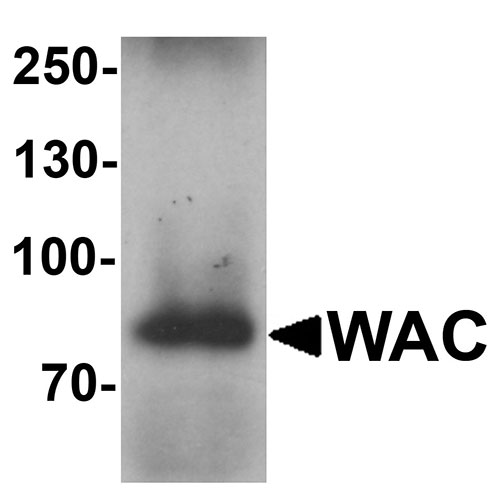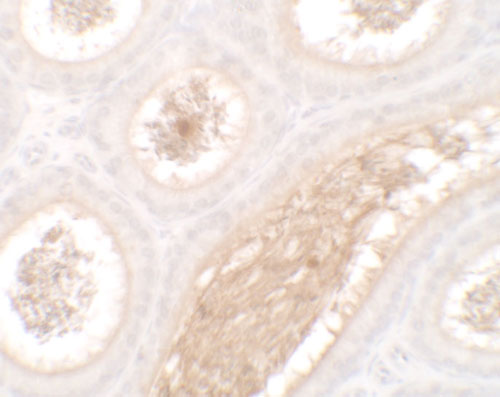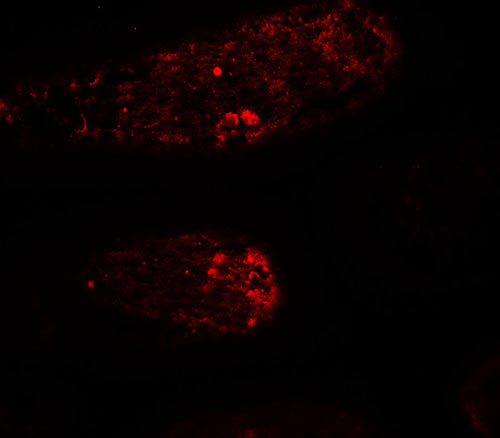WAC Antibody
- 产品详情
- 实验流程
- 背景知识
Application
| WB, IF, E, IHC-P |
|---|---|
| Primary Accession | Q9BTA9 |
| Other Accession | NP_057712, 18379328 |
| Reactivity | Human, Mouse, Rat |
| Host | Rabbit |
| Clonality | Polyclonal |
| Isotype | IgG |
| Calculated MW | 70724 Da |
| Concentration (mg/ml) | 1 mg/mL |
| Conjugate | Unconjugated |
| Application Notes | WAC Antibody can be used for detection of WAC by Western blot at 1 µg/mL. |
| Gene ID | 51322 |
|---|---|
| Other Names | WW domain-containing adapter protein with coiled-coil, WAC, KIAA1844 |
| Target/Specificity | WAC; At least two isoforms of WAC are known to exist; this antibody will detect the larger isoform. |
| Reconstitution & Storage | WAC antibody can be stored at 4℃ for three months and -20℃, stable for up to one year. |
| Precautions | WAC Antibody is for research use only and not for use in diagnostic or therapeutic procedures. |
| Name | WAC |
|---|---|
| Synonyms | KIAA1844 |
| Function | Acts as a linker between gene transcription and histone H2B monoubiquitination at 'Lys-120' (H2BK120ub1) (PubMed:21329877). Interacts with the RNA polymerase II transcriptional machinery via its WW domain and with RNF20-RNF40 via its coiled coil region, thereby linking and regulating H2BK120ub1 and gene transcription (PubMed:21329877). Regulates the cell-cycle checkpoint activation in response to DNA damage (PubMed:21329877). Positive regulator of amino acid starvation-induced autophagy (PubMed:22354037). Also acts as a negative regulator of basal autophagy (PubMed:26812014). Positively regulates MTOR activity by promoting, in an energy-dependent manner, the assembly of the TTT complex composed of TELO2, TTI1 and TTI2 and the RUVBL complex composed of RUVBL1 and RUVBL2 into the TTT-RUVBL complex. This leads to the dimerization of the mTORC1 complex and its subsequent activation (PubMed:26812014). May negatively regulate the ubiquitin proteasome pathway (PubMed:21329877). |
| Cellular Location | Nucleus speckle {ECO:0000250|UniProtKB:Q924H7}. Nucleus. Note=In distinct nuclear speckles. Colocalizes with pre-mRNA processing complexes {ECO:0000250|UniProtKB:Q924H7} |
For Research Use Only. Not For Use In Diagnostic Procedures.
Provided below are standard protocols that you may find useful for product applications.
BACKGROUND
WAC Antibody: The WW domain containing adaptor with coiled-coil protein (WAC) contains a WW domain that mediates protein-protein interactions and colocalizes with RNA splicing factor SC35. Further studies have indicated that WAC is a functional partner of the RNF20/40 complex that ubiquitinates Histone H2B, and that WAC regulates H2B ubiquitination. WAC targets RNF20/40 to associate with RNA polymerase II complex for H2B ubiquitination at active transcription sites. WAC-dependent transcription is also important for cell-cycle checkpoint activation in response to genotoxic stress.
REFERENCES
Xu GM and Arnaout MA. WAC, a novel WW domain-containing adapter with a coiled-coil region, is colocalized with splicing factor SC35. Genomics 2002; 79:87-94.
Zhang F and Yu X. WAC, a functional partner of RNF20/40, regulates histone H2B ubiquitination and gene transcription. Mol. Cell 2011; 41:384-97.
终于等到您。ABCEPTA(百远生物)抗体产品。
点击下方“我要评价 ”按钮提交您的反馈信息,您的反馈和评价是我们最宝贵的财富之一,
我们将在1-3个工作日内处理您的反馈信息。
如有疑问,联系:0512-88856768 tech-china@abcepta.com.























 癌症的基本特征包括细胞增殖、血管生成、迁移、凋亡逃避机制和细胞永生等。找到癌症发生过程中这些通路的关键标记物和对应的抗体用于检测至关重要。
癌症的基本特征包括细胞增殖、血管生成、迁移、凋亡逃避机制和细胞永生等。找到癌症发生过程中这些通路的关键标记物和对应的抗体用于检测至关重要。 为您推荐一个泛素化位点预测神器——泛素化分析工具,可以为您的蛋白的泛素化位点作出预测和评分。
为您推荐一个泛素化位点预测神器——泛素化分析工具,可以为您的蛋白的泛素化位点作出预测和评分。 细胞自噬受体图形绘图工具为你的蛋白的细胞受体结合位点作出预测和评分,识别结合到自噬通路中的蛋白是非常重要的,便于让我们理解自噬在正常生理、病理过程中的作用,如发育、细胞分化、神经退化性疾病、压力条件下、感染和癌症。
细胞自噬受体图形绘图工具为你的蛋白的细胞受体结合位点作出预测和评分,识别结合到自噬通路中的蛋白是非常重要的,便于让我们理解自噬在正常生理、病理过程中的作用,如发育、细胞分化、神经退化性疾病、压力条件下、感染和癌症。








